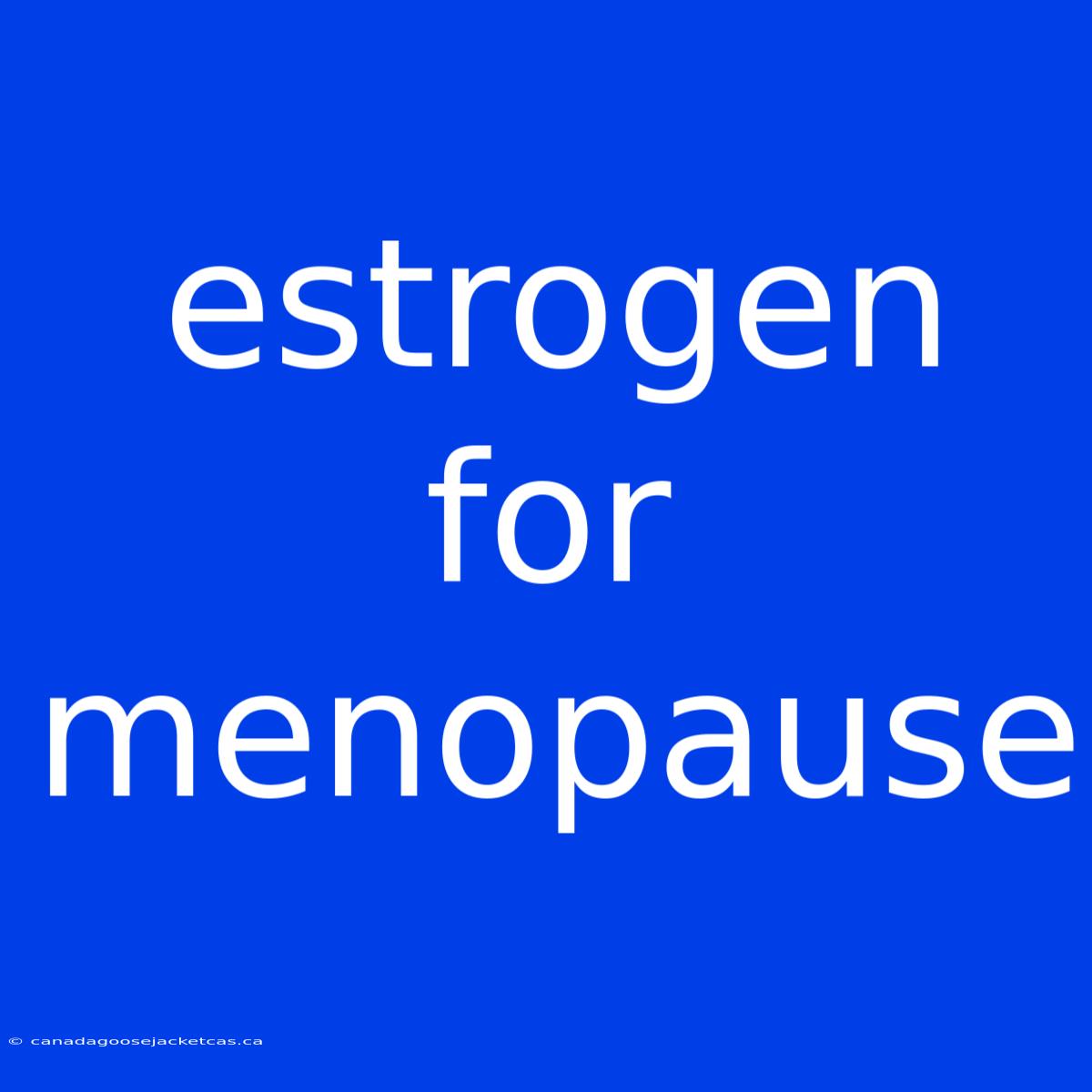Estrogen for Menopause: Understanding the Benefits and Risks
Is estrogen therapy the answer to menopause symptoms? Estrogen therapy can be an effective treatment for menopausal symptoms, but it's essential to weigh the benefits against potential risks. This comprehensive guide explores the ins and outs of estrogen for menopause, providing valuable insights for women considering this treatment option.
Editor Note: This article explores the multifaceted topic of estrogen therapy for menopause, offering in-depth analysis and clarity on its uses, potential benefits, and associated risks.
Why is this topic crucial? Menopause is a natural transition, but it can bring about a host of challenging symptoms like hot flashes, night sweats, vaginal dryness, mood swings, and bone loss. Estrogen therapy can help alleviate these symptoms, improving overall quality of life for many women. However, it's essential to understand the potential risks and weigh them carefully against the potential benefits.
Our Analysis: We delved into scientific research, medical guidelines, and expert opinions to create this comprehensive guide on estrogen therapy for menopause. We've analyzed the various types of estrogen therapy, the benefits and risks associated with each, and the factors to consider when deciding if estrogen therapy is right for you.
Key Considerations for Estrogen Therapy:
| Aspect | Description |
|---|---|
| Types of Estrogen | Oral, topical, vaginal, and transdermal forms are available. |
| Benefits | Relief from hot flashes, night sweats, vaginal dryness, and bone loss. |
| Risks | Increased risk of blood clots, stroke, breast cancer, and heart disease. |
| Eligibility | Depends on individual medical history, age, and lifestyle factors. |
| Monitoring | Regular checkups and screenings are necessary to ensure safety. |
Estrogen Therapy for Menopause: A Closer Look
Estrogen therapy is not a one-size-fits-all solution. Understanding the different types, potential benefits, and potential risks is crucial for making informed decisions.
Types of Estrogen Therapy
- Oral Estrogen: This is the most common type, taken as pills.
- Topical Estrogen: Applied to the skin as a cream, gel, or patch, delivering estrogen directly to the target area.
- Vaginal Estrogen: Available in creams, tablets, rings, or pessaries, it helps alleviate vaginal dryness and related symptoms.
- Transdermal Estrogen: Patches applied to the skin, allowing for continuous absorption of estrogen.
Potential Benefits of Estrogen Therapy
- Alleviating Menopausal Symptoms: Estrogen therapy effectively addresses hot flashes, night sweats, vaginal dryness, mood swings, and sleep disturbances.
- Improving Bone Health: Estrogen plays a vital role in bone density. Estrogen therapy can help prevent or slow down bone loss, reducing the risk of osteoporosis.
- Cognitive Function: Some studies suggest that estrogen therapy might have a positive impact on cognitive function and memory in postmenopausal women.
Potential Risks of Estrogen Therapy
- Increased Risk of Blood Clots: Estrogen therapy can increase the risk of blood clots in the legs or lungs.
- Stroke: Women using estrogen therapy might have a slightly higher risk of stroke, especially those with pre-existing conditions.
- Breast Cancer: Long-term use of estrogen therapy, especially combined with progesterone, might increase the risk of breast cancer in some women.
- Heart Disease: Estrogen therapy can increase the risk of heart disease in certain women, especially those with pre-existing conditions.
Eligibility for Estrogen Therapy
- Medical History: A thorough medical history evaluation is essential to identify any pre-existing conditions that might make estrogen therapy unsuitable.
- Age: Age is a factor, and women with a uterus should also use progesterone alongside estrogen therapy.
- Lifestyle Factors: Lifestyle factors such as smoking, obesity, and a family history of certain conditions can influence the suitability of estrogen therapy.
Monitoring and Follow-up Care
- Regular Checkups: Regular checkups with your healthcare provider are crucial for monitoring the effectiveness of estrogen therapy and identifying any potential side effects.
- Screenings: Specific screenings, including mammograms and Pap tests, are important for detecting any health issues early on.
Frequently Asked Questions
- Q: Can I take estrogen therapy after menopause?
- A: Yes, estrogen therapy is typically prescribed after menopause to manage menopausal symptoms.
- Q: Is estrogen therapy safe for everyone?
- A: No, estrogen therapy isn't suitable for everyone, and the risks and benefits need to be carefully weighed.
- Q: Can estrogen therapy cause breast cancer?
- A: Long-term use of estrogen therapy, especially in combination with progesterone, can slightly increase the risk of breast cancer.
- Q: How long can I take estrogen therapy?
- A: The duration of estrogen therapy depends on individual needs and medical considerations.
- Q: What are the side effects of estrogen therapy?
- A: Possible side effects include breast tenderness, headaches, nausea, and weight gain.
- Q: Are there alternative treatments for menopause symptoms?
- A: Yes, alternative options include lifestyle changes, herbal supplements, and other hormone therapies.
Tips for Managing Menopause Symptoms
- Healthy Lifestyle: Maintaining a healthy lifestyle, including regular exercise, a balanced diet, and managing stress, can help alleviate menopause symptoms.
- Alternative Therapies: Consider exploring alternative therapies like acupuncture, yoga, or meditation.
- Seek Expert Advice: Consult with your healthcare provider to discuss the most suitable treatment options for your individual needs.
In Conclusion:
Estrogen therapy can be a valuable tool for managing menopausal symptoms, but it's crucial to understand the potential risks and benefits. A personalized approach, including open communication with your healthcare provider and a careful consideration of your individual health history, is essential for making informed decisions about estrogen therapy.

